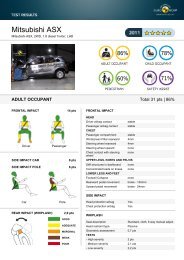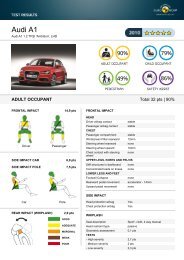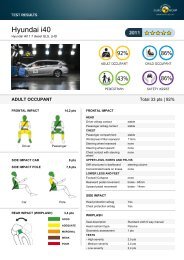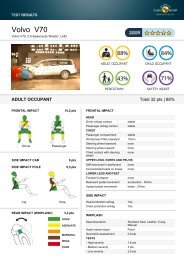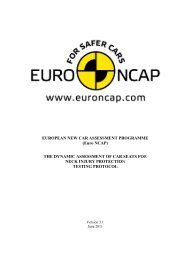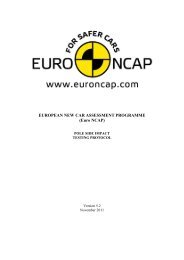Pedestrian Test Protocol - Euro NCAP
Pedestrian Test Protocol - Euro NCAP
Pedestrian Test Protocol - Euro NCAP
You also want an ePaper? Increase the reach of your titles
YUMPU automatically turns print PDFs into web optimized ePapers that Google loves.
3 VEHICLE MARKING<br />
3.1 General<br />
3.1.1 The vehicle shall be marked with a grid as described in the following sections. The<br />
marking procedures divide the front and bonnet of the car into zones which are then<br />
assessed using appropriate impactors.<br />
3.1.2 Where no predicted data is to be provided by the vehicle manufacturer, the testable<br />
area shall be marked as described in the <strong>Euro</strong> <strong>NCAP</strong> <strong>Pedestrian</strong> <strong>Test</strong>ing <strong>Protocol</strong><br />
version 5.3.1, November 2011.<br />
3.1.3 All markings and measurements should be made with the vehicle in its Normal Ride<br />
Attitude.<br />
3.1.4 The vehicle manufacturer must provide <strong>Euro</strong> <strong>NCAP</strong> with coordinates of all grid points<br />
derived from either CAE data or physical mark out.<br />
3.1.5 A comparison of the grid origin C0,0 and two other points on 2100WAD, will be<br />
made between the laboratory mark out and the data provided by the vehicle<br />
manufacturer. For manufacturer data to be accepted, grid points must be within 10mm<br />
of each other.<br />
3.1.6 Where the grid points of <strong>Euro</strong> <strong>NCAP</strong> and vehicle manufacturer are within 10mm of<br />
each other the laboratory mark-out shall be used.<br />
3.1.7 Where the two grids differ by more than 10mm the vehicle manufacturer shall be<br />
informed and both markings will be examined in greater detail to establish the cause of<br />
any differences. The Secretariat will then take a decision as to how to proceed with<br />
vehicle marking.<br />
3.1.8 The vehicle manufacturer must provide data for all headform grid locations. <strong>Test</strong>ing<br />
will be carried out by <strong>Euro</strong> <strong>NCAP</strong> to a number of locations to verify the accuracy of<br />
data provided by the vehicle manufacturer.<br />
3.1.9 For vehicles fitted with active bonnets, the headform impactor marking will be applied<br />
to the vehicle with the bonnet in the undeployed state. This will be the case regardless<br />
of whether or not the bonnet is locking or non-locking.<br />
3.1.10 For vehicles fitted with active bonnets, the bonnet leading edge line will be marked on<br />
the vehicle with the bonnet in the un-deployed state. If bonnet deployment occurs prior<br />
to the pedestrian contact with the bonnet leading edge (BLE), creating an increased<br />
hazard such as higher BLE height and/or bumper lead, the <strong>Euro</strong> <strong>NCAP</strong> secretariat will<br />
give consideration to marking out the BLE in the deployed state.<br />
Note: Marking in the undeployed state was chosen to avoid the possibility of<br />
discontinuities in the test areas leading to anomalies or inconsistencies in the test<br />
results.<br />
3.1.11 Where the vehicle manufacturer provides data showing that a deployable bonnet<br />
system offers protection to the upper leg, the upper legform to BLE tests will be<br />
carried out by conducting dynamic tests. The BLE will be marked on the vehicle in the<br />
deployed position.<br />
3.2 Bumper Reference Lines<br />
For vehicles with an identifiable bumper structure the upper Bumper Reference Line is defined<br />
as the geometric trace of the upper most points of contact between a straight edge and the<br />
bumper, when the straight edge, held parallel to the vertical longitudinal plane of the car and<br />
inclined rewards by 20 degrees, is traversed across the front of the car whilst maintaining contact<br />
with the upper edge of the bumper. For a vehicle with no identifiable bumper structure it is<br />
defined as the geometric trace of the upper most points of contact between a straight edge 700<br />
mm long and the bumper, when the straight edge, held parallel to the vertical longitudinal plane<br />
Version 7.0<br />
March 2013<br />
11



